Paul F. Hoffman
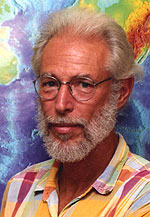 Paul F. Hoffman is a
tectonic and sedimentary field geologist in the Department of Earth and Planetary
Sciences at Harvard University, Cambridge, MA (USA). Early in his career
he was a pioneer in the comparison of Holocene and Proterozoic carbonates,
and
in
the application
of plate tectonics to the Proterozoic. His snowball earth related studies
originated in northern Namibia, where he has worked annually since 1993.
His graduate students Galen P. Halverson, Adam C. Maloof, Francis X. Macdonald
and David S. Jones have conducted stratigraphic, chemostratigraphic and paleomagnetic
research in Svalbard, Morocco, Arctic Alaska and northwest Canada. Paul F. Hoffman is a
tectonic and sedimentary field geologist in the Department of Earth and Planetary
Sciences at Harvard University, Cambridge, MA (USA). Early in his career
he was a pioneer in the comparison of Holocene and Proterozoic carbonates,
and
in
the application
of plate tectonics to the Proterozoic. His snowball earth related studies
originated in northern Namibia, where he has worked annually since 1993.
His graduate students Galen P. Halverson, Adam C. Maloof, Francis X. Macdonald
and David S. Jones have conducted stratigraphic, chemostratigraphic and paleomagnetic
research in Svalbard, Morocco, Arctic Alaska and northwest Canada.
Selected bibliography
Hoffman, P.F., Kaufman, J.A. & Halverson, G.P., 1998. Comings and goings of global glaciations on a Neoproterozoic carbonate platform in Namibia. GSA Today 8,1-9.
Hoffman, P.F., Kaufman, A.J., Halverson, G.P. & Schrag, D.P., 1998. A Neoproterozoic snowball Earth. Science 281, 1342-46.
Hoffman, P.F., 1999. The break-up of Rodinia, birth of Gondwana, true polar wander and the snowball Earth. Journal of African Earth Sciences 28, 17-33.
Hoffman, P.F. & Schrag, D.P., 2000. Snowball Earth. Scientific American 282, 68-75.
Halverson, G.P., Hoffman, P.F., Schrag, D.P. & Kaufman, J.A., 2002. A major perturbation of the carbon cycle before the Ghaub glaciation (Neoproterozoic) in Namibia: Prelude to snowball Earth? Geophysics, Geochemistry, Geosystems 3, 10.1029/2001GC000244.
Hoffman, P.F., 2002. Carbonates bounding glacial deposits: Evidence for Snowball Earth episodes and greenhouse aftermaths in the Neoproterozoic Otavi Group of northern Namibia. Excursion Guide, 16th International Sedimentological Conference, Auckland Park, South Africa, 39 p.
Hoffman, P.F. & Schrag, D.P., 2002. The snowball Earth hypothesis: testing the limits of global change. Terra Nova 14, 129-155.
Schrag, D.P., Berner, R.A., Hoffman, P.F. & Halverson, G.P. 2002. On the initiation of a snowball Earth. Geophysics, Geochemistry, Geosystems 3, 10.1029/2001GC000219.
Halverson, G.P., Maloof, A.C., and Hoffman, P.F., 2004. The Marinoan glaciation (Neoproterozoic) in northeast Svalbard. Basin Research 16, 297-324, 10.1111/j.1365-2117.2004.00234.x
Allen, P.A. and Hoffman, P.F., 2005. Extreme winds and waves in the aftermath of a Neoproterozoic glaciation. Nature 433, 123-127.
Halverson, G.P., Hoffman, P.F., Schrag, D.P., Maloof, A.C., and Rice, A.H.N., 2005. Toward a Neoproterozoic composite carbon-isotope record. Geological Society of America Bulletin 117, 1181-1207, 10.1130/B25630.1
Hoffman, P.F., 2005. On Cryogenian (Neoproterozoic) ice-sheet dynamics and the limitations of the glacial sedimentary record (28th Alex. Du Toit Memorial Lecture). Journal of South African Geology 00, 000-000.
Hoffman, P.F. and Halverson, G.P., in press. Otavi Group of the Northern Platform and the Northern Margin Zone. In: The Handbook of Namibian Geology (R.McG. Miller, ed.), Geological Survey of Namibia, Windhoek.
Maloof, A.C., Halverson, G.P., Kirschvink, J.L., Schrag, D.P., Weiss, B.P., and Hoffman, P.F., in press. Combined paleomagnetic, isotopic and stratigraphic evidence for true polar wander from the Neoproterozoic Akademikerbreen Group, Svalbard. Geological Society of America Bulletin.
Joseph L. Kirschvink
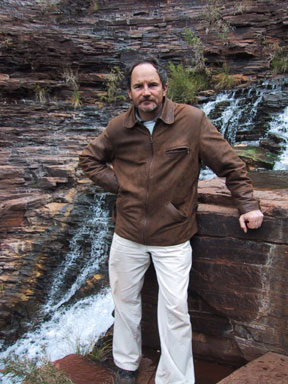 Joe was born and raised in the
Southwest United States, which does not necessarily explain his infatuation
with geology and biology, but it helps.
Rather than attending an undergraduate university on the East Coast, where
all of the rocks are covered with green goo, Joe chose to pursue his undergraduate
education in Pasadena, California,
where the atmosphere itself in the early 1970s was capable of cleaning the
rock surfaces to show the beautiful geology underneath. However, upon the
advice of two mentors (one with his
magnetic mind in the stars, and the other more mindful of the magnetic minerals
made by microbes), he reluctantly agreed to serve time in the East among
the Ivy leaves at Princeton for his Ph.D. Joe did this, however, by traveling
through Australia for a year (he recently went back, and is shown here standing
on the Hamersly banded iron formation), and by spending about 50% of this
time as a graduate student somewhere "in the field". He abandoned his experiment
with the East Coast in 1981, and has been on the faculty back at Caltech
ever since. Joe was born and raised in the
Southwest United States, which does not necessarily explain his infatuation
with geology and biology, but it helps.
Rather than attending an undergraduate university on the East Coast, where
all of the rocks are covered with green goo, Joe chose to pursue his undergraduate
education in Pasadena, California,
where the atmosphere itself in the early 1970s was capable of cleaning the
rock surfaces to show the beautiful geology underneath. However, upon the
advice of two mentors (one with his
magnetic mind in the stars, and the other more mindful of the magnetic minerals
made by microbes), he reluctantly agreed to serve time in the East among
the Ivy leaves at Princeton for his Ph.D. Joe did this, however, by traveling
through Australia for a year (he recently went back, and is shown here standing
on the Hamersly banded iron formation), and by spending about 50% of this
time as a graduate student somewhere "in the field". He abandoned his experiment
with the East Coast in 1981, and has been on the faculty back at Caltech
ever since.
Joe has a lot of fun creating "nutty" ideas like the snowball Earth, and confusing paleontologists by trying to convince them that the Cambrian explosion was caused by a series of interchange events in the orthonormal Eigenvectors of Earth's Moment of Inertia Tensor. (A good number of paleontologists actually know what a tensor is, and realize that a moment of inertia is not just what keeps them in bed in the morning ─.)
Joe even pretends that animals can predict earthquakes, just to keep his seismological
colleagues on their toes. His major claim to being a paleontologist is his
prediction and discovery of magnetofossils, which are not very useful for
biostratigraphy but are wonderful as a Martian biomarker and for increasing
the NASA Astrobiology budget.
Joe likes to swim and ski, and to explore the hot mineral waters produced
by Mother Earth. He is married to a neurobiological electron microscopist,
Atsuko Kobayashi, and they have two children (Jiseki and Koseki), whose names
mean "magnetite" and "gemstone" respectively in
Japanese. As a result, the children will probably grow up to be bloodsucking
lawyers. And his family still doesn't know if home is in Pasadena or Osaka
A more extensive biography and bibliography is located here.
Selected Publications:
Kopp, R.E., Kirschvink, J.L., Hilburn, I.A. & Nash, C.Z., 2005, Was the Paleoproterozoic Snowball Earth a biologically-triggered climate disaster?,
Proc. Natl. Acad. Sci. 102: 11131-11136.
Hilburn, I.A., Kirschvink, J.L., Tajika, E., Tada, R., Hamano, Y., and
Yamamoto, S., A., 2005, negative fold test on the Lorrain Formation of
the Huronian Supergroup:
Uncertainty on the paleolatitude of the Paleoproterozoic Gowganda glaciation
and implications for the great oxygenation event, Earth & Planetary Science
Letters 232, 315-332.
Kirschvink, J.L. & Raub, T.D., 2003, A Methane Fuse for the Cambrian Explosion:
Carbon Cycles and True Polar Wander. Comptes Rendus Geosciences, .,v.335, 65-78.
M.W. Martin, D.V. Grazhdankin, S.A. Bowring, D.A.D. Evans, M. A. Fedonkin,
J.L. Kirschvink, 2000, Age of Neoproterozoic Bilatarian Body and Trace Fossils,
White
Sea, Russia: Implications for Metazona Evolution. Science 288: 841-845.
Evans, D.A.D., Li, Z.X., Kirschvink, J.L, Wingate, M.T.D., 2000, A
high-quality mid-Neoproterozoic paleomagnetic pole from South China, with implications
for ice ages, regional stratigraphy, and the breakup configuration of Rodinia.
Precambrian Research 100: (1-3) 313-334, 2000.
Kirschvink, J.L., Gaidos, E.J., Bertani, L.E., Beukes, N.J., Gutzmer, J.,
Maepa, L.N., and Steinberger, R.E., 2000, Paleoproterozoic
Snowball Earth: Extreme climatic and geochemical global change and its biological
consequences. Proc. Natl. Acad. Sciences 97(4): 1400-1405.
Evans, D.A., Beukes, N.J., & Kirschvink, J.L.,. 1997, Low-latitude glaciation
in
the
Paleoproterozoic. Nature 386 (6622): 2626-266.
Kirschvink J.L., 1992, Late
Proterozoic Low-Latitude Global Glaciation: The Snowball Earth. Section
2.3 in: J.W. Schopf, C. Klein, & D. Des Maris (eds), The Proterozoic Biosphere:
A Multidisciplinary Study. Cambridge University Press, pp. 51-52.
Lynn Margulis
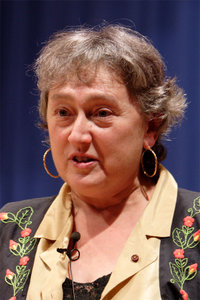 Lynn Margulis (born 1938) is a biologist and a professor at the University of
Massachusetts Amherst. In 1967 she proposed a contentious new hypothesis which
became her most important scientific contribution as the endosymbiotic theory
of the origin of mitochondria as separate organisms that long ago entered a symbiotic
relationship with eukaryotic cells through endosymbiosis.
"She is best known for her theory of symbiogenesis, which challenges a central
tenet of neodarwinism. She argues that inherited variation, significant in evolution,
does not come mainly from random mutations. Rather new tissues, organs, and even
new species evolve primarily through the long-lasting intimacy of strangers.
The fusion of genomes in symbioses followed by natural selection, she suggests,
leads to increasingly complex levels of individuality."
"After the proposal of the endosymbiotic theory, Margulis predicted that
if organelles were prokaryotic symbionts, then the organelles will have their
own DNA that
would be different from the DNA of the cell. This prediction was actually proven
in the 1980's in mitochondria, centrioles, and chloroplasts."
She was criticized as a radical and her scientific work was rejected by mainstream
biology for many years. Her work has more recently received widespread support
and acclaim. Prominent evolutionary biologist Richard Dawkins recently said that
her theory that the eukaryotic cell is a symbiotic union of primitive prokaryotic
cells "is one of the great achievements of twentieth-century evolutionary
biology, and I greatly admire her for it."
Margulis was inducted into the World Academy of Art and Science, the Russian
Academy of Natural Sciences, and the American Academy of Arts and Sciences between
1995 and 1998.
She is also a proponent and co-developer of the modern version of Gaia theory,
based on an idea developed by the English atmospheric scientist James Lovelock.
She was the first wife of astronomer Carl Sagan and is the mother of Dorion Sagan,
popular science writer and co-author, Jeremy Sagan, software developer and founder
of Sagan Technology, Zachary Margulis, lawyer and Jennifer Margulis, teacher
and author.
Selected Publications
Margulis, Lynn, 1970, Origin of Eukaryotic Cells, Yale University Press, ISBN
0300013531
Margulis, Lynn, 1982, Early Life, Science Books International, ISBN 0867200057
Margulis, Lynn and Dorion Sagan, 1986, Origins of Sex: Three Billion Years of
Genetic Recombination, Yale University Press, ISBN 0300033400
Margulis, Lynn and Dorion Sagan, 1987, Microcosmos: Four Billion Years of Evolution
from Our Microbial Ancestors, HarperCollins, ISBN 004570015X
Margulis, Lynn and Dorion Sagan, 1991, Mystery Dance: On the Evolution of Human
Sexuality, Summit Books, ISBN 0671633414
Margulis, Lynn, ed, 1991, Symbiosis as a Source of Evolutionary Innovation: Speciation
and Morphogenesis, The MIT Press, ISBN 0262132699
Margulis, Lynn, 1992, Symbiosis in Cell Evolution: Microbial Communities in the
Archean and Proterozoic Eons, W.H. Freeman, ISBN 0716770288
Margulis, Lynn and Dorion Sagan, 1997, Slanted Truths: Essays on Gaia, Symbiosis,
and Evolution, Copernicus Books, ISBN 0387949275
Lynn Margulis and Karlene V. Schwartz, 1997, Five Kingdoms: An Illustrated Guide
to the Phyla of Life on Earth, W.H. Freeman & Company, ISBN 0613923383
Margulis, Lynn, 1998, Symbiotic Planet: A New Look at Evolution, Basic Books,
ISBN 0465072712
Margulis, Lynn and Dorion Sagan, 2002, Acquiring Genomes: A Theory of the Origins
of Species, Perseus Books Group, ISBN 0465043917
Margulis, Lynn, et. al., 2002, The Ice Chronicles: The Quest to Understand Global
Climate Change, University of New Hampshire, ISBN 1584650621
Sir Douglas Mawson
Sir Douglas Mawson, geologist and explorer, was born in Yorkshire, on 5 May 1882. He grew up and was educated in Rooty Hill, near Sydney, and studies mining engineering at the University of Sydney, graduating in 1902.
His first scientific exploration was in 1903 when he made a geological survey of Vanuatu. His report of the exploration, The Geology of the New Hebrides, was one of the first major investigations into the island's geology.
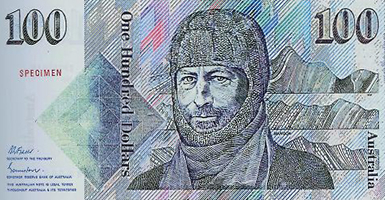 Mawson undertook further study in geology and became a pioneer in the field of chemical aspects of geology and geo- chemistry. In 1905 he was appointed Lecturer in Mineralogy and Petrology at the University of Adelaide and he became interested in glacial geology. Mawson identified, and first described, the mineral 'davidite' (titanium and uranium) at Radium Hill, the first deposits of radioactive ore found in Australia. Mawson undertook further study in geology and became a pioneer in the field of chemical aspects of geology and geo- chemistry. In 1905 he was appointed Lecturer in Mineralogy and Petrology at the University of Adelaide and he became interested in glacial geology. Mawson identified, and first described, the mineral 'davidite' (titanium and uranium) at Radium Hill, the first deposits of radioactive ore found in Australia.
Mawson's first expedition to the Antarctic was in 1907 when he travelled as 'physicist'. On this expedition he was one of the first party to climb Mount Erebus, and he and two others were the first to reach the vicinity of the South Pole. On returning he published significant accounts of his observations of the aurora and geomagnetism.
In 1911 with government and private sector backing, Mawson and the expedition party sailed to Antarctica for further scientific investigation. It was at Commonwealth Bay, where Mawson led the Far Eastern Expedition, that the extent of Mawson's bravery and perseverance was shown. About 500km from the station one of the party of threes, BES Ninnis, and his sledge and doge team broke through a crevasse lid and disappeared. Since their supplies were severely diminished, Mawson and the other remaining expedition member, X Mertz, decided to return to the station. After 25 days, probably from the combined effects of hard physical labour, exertion, starvation and poisoning from eating the Vitamin A rich huskies, Mertz died. Now alone, Mawson discarded any non- essentials, except geological specimens and records of the journey, and with a pocket saw cut his sledge in half and, for 30 days, dragged it the last 160 kilometres back to the station. A small party had waited to search for him; they remained in the Antarctic for another year. While recuperating, Mawson wrote, The Home of the Blizzard, an account of the ordeal.
Mawson organised and led the British, Australian and New Zealand Antarctic Research Expedition in 1929. The expedition made extensive geological and biological investigations and with the use of a small aircraft, mapped much of the coast.
Mawson was Knighted in 1914 and received an OBE in 1920. In 1921 he was appointed Professor of Geology and Mineralogy at the University of Adelaide. Despite help from other eminent scientists to analyse and report on the data collected in Antarctica, the Scientific Reports of the 1911 expedition were not published until 1947. Sir Douglas Mawson died in 1958.
Mark A. S. McMenamin
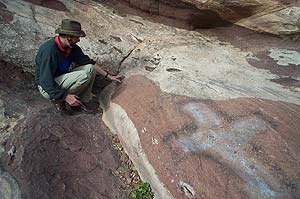 Mark A. S. McMenamin is a geologist
and paleontologist and is currently chair of the Department of Earth and Environment
at Mount Holyoke College. His research career has focused on the geological and
especially paleobiological events that took place during late Proterozoic time.
He has a special interest in the Ediacaran biota, Cambrian small shelly fossils,
archeocyaths, and trace fossils of the Proterozoic-Cambrian transition interval.
He also has participated in research that led to the naming of the supercontinent
Rodinia. Mark discovered a “deep Proterozoic” assemblage of Ediacaran
fossils and trace fossils in the Cerro Rajón, Sonora, Mexico. Basing his
conclusions on theoretical considerations, Mark correctly predicted that conularids
would be found among the Ediacaran biota. Mark’s work on the Cambrian shelly
fossil genus Mickwitzia helped to define this group as a stem-group (and possibly
pre-bivalved) type of early brachiopod. His work on Vermiforma from North Carolina
has shed new light on this enigmatic trace fossil. Mark and Patricia Weaver of
the North Carolina State Museum of Natural sciences recently revised the taxonomy
of the Ediacaran Pteridinium carolinaensis and also named the a new Cambrian
trilobite species Paradoxides from the Carolina Slate Belt. Mark is currently
assisting in the effort to define the relationship of continental blocks such
as Avalonia and the Carolina Terrane to larger continents as a means of refining
the Rodinia reconstruction.
Mark is also interested in the relationship between global climate and the biosphere
over time. Two of his courses at Mount Holyoke College, The Biosphere (a semester
course) and Snowball Earth (a January term course) focus intently on the problems
associated with Proterozoic glaciations.
Mark’s books include The Emergence of Animals (with Dianna McMenamin, Columbia
University Press); Hypersea: Life on Land (with Dianna McMenamin, Columbia);
and The Garden of Ediacara: Discovering the First Complex Life (Columbia). With
Gregory Jenkins, Christopher McKay, and Linda Sohl, Mark co-edited The Extreme
Proterozoic: Geology, Geochemistry, and Climate (American Geophysical Union).
Mark also edited the English versions of Vladimir Vernadsky’s groundbreaking
book The Biosphere (Copernicus/Springer Verlag) and Corneille-Jean Koene’s
pioneering work The Chemical Constitution of the Atmosphere from Earth’s
Origin to the Present, and its Implications for Protection of Industry and Ensuring
Environmental Quality (Edwin Mellen Press).
Selected bibliography
McMenamin, M. A. S. 2005. Microbial influence and environmental convergence in
marine (Proterozoic) and lacustrine (Jurassic) depositional settings. Geological
Society of America Abstracts with Programs v. 37, n. 1, p. 7.
McMenamin, M. A. S. 2004. Gaia and Glaciation: Lipalian (Vendian) Environmental
Crisis. In S. H. Schneider, J. R. Miller, E. Crist, and P. J. Boston, eds., Scientists
Debate Gaia: The Next Century, The MIT Press, Cambridge, Massachusetts, pp. 115-127.
ISBN 0262194988.
McMenamin, M. A. S. and P. G. Weaver. 2004. Middle Cambrian polymeroid trilobites
and correlation of the Carolina and Augusta terranes. Southeastern Geology v.
43, p. 21-38.
McMenamin, M. A. S., ed. 2004. An English Translation of “The Chemical
Constitution of the Atmosphere from Earth’s Origin to the Present, and
its Implications for Protection of Industry and Ensuring Environmental Quality”by
C.-J. Koene (1856).Translated and edited by Mark A. S. McMenamin. Mellen Press,
New York. ISBN 0773463879.
McMenamin, M. A. S. 2004. Precambrian: Vendian and Ediacaran. In R. C. Selley,
R. M. Cocks and I. R. Plimer, eds., Encyclopedia of Geology, Elsevier Press,
Oxford, v. 4, p. 371-381. ISBN 0126363803 (set of five volumes); 0126363854 (volume
4).
Jenkins, G. S., M. A. S. McMenamin, C. P. McKay, and L. H. Sohl, eds. 2004. The
Extreme Proterozoic: Geology, Geochemistry, and Climate. American Geophysical
Union Geophysical Monography 146, Washington, DC. ISBN 08875904114.
McMenamin, M. A. S. 2003. Spriggina is a trilobitoid ecdysozoan. Geological Society
of America Abstracts with Programs v. 35, n. 6, p. 105-106.
McMenamin, M. A. S. 2003. Origin and early evolution of predators: The ecotone
model and early evidence for macropredation. In P. H. Kelley, M. Kowalewski and
T. A. Hansen, eds., Predator-Prey Interactions in the Fossil Record, Kluwer Academic/Plenum
Publishers, New York, pp. 379-400. ISBN 0306474891.
McMenamin, M. A. S. and P. G. Weaver. 2002. Proterozoic-Cambrian paleobiogeography
of the Carolina terrane. Southeastern Geology v. 41, n. 2, p. 119-128.
McMenamin, M. A. S. 2001. The Evolution of the Noösphere. American Teilhard
Association for the Future of Man Teilhard Studies 42, New York. ISBN 0890120854.
McMenamin, M. A. S., F. Debrenne and A. Yu. Zhuravlev. 2000. Early Cambrian Appalachian
Archaeocyaths: Further age constraints from the fauna of New Jersey and Virginia,
U.S.A. Geobios v. 33, n. 6, p. 693-708.
MeMenamin, M. A. S. 2000. Out of the shadows. [Book review of Simon Conway Morris,
The Crucible of Creation: The Burgess Shale and the Rise of Animals]. Notes and
Records of the Royal Society of London, v. 54, n. 3, p. 407-408.
McMenamin, M. A. S. 1999. Problematic animals: Phanerozoic problematica. In R.
Singer, ed., Encyclopedia of Paleontology, Volume 2, M-Z. Fitroy Dearborn Publishers,
Chicago, Illinois, pp. 959-960. ISBN 1884964966.
McMenamin, M. A. S. 1998. The Garden of Ediacara: Discovering the First Complex
Life. Columbia University Press, New York. ISBN 0-231-10558-4 [hardcover]; ISBN
0231105592 [paper].
Vernadsky, V. I. 1998. The Biosphere. Translated by David B. Langmuir, edited
by Mark A. S. McMenamin. Springer-Verlag (Copernicus), New York. ISBN 038798268X.
McMenamin, M. A. S. 1996. Ediacaran biota from Sonora, Mexico. Proceedings of
the National Academy of Sciences (USA) v. 93, p. 4990-4993.
|